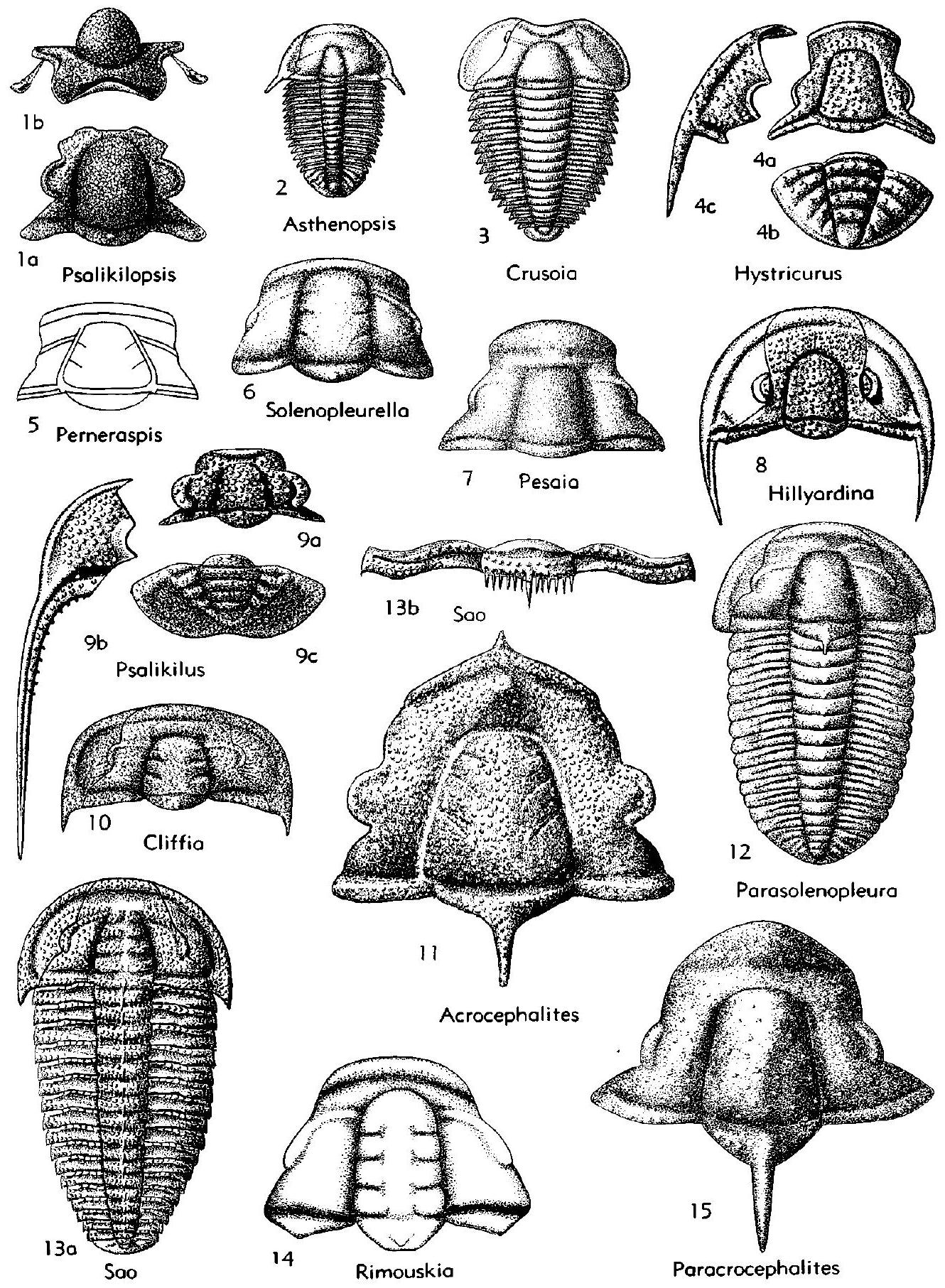Welcome to the Treatise on Invertebrate Paleontology!
Please enter a genera name to retrieve more information.

Sao
Classification
Phylum:
Arthropoda
Subphylum:
Trilobitomorpha
Class:
Trilobita
Order:
Ptychopariida
Suborder:
Ptychopariina
Superfamily:
Solenopleuracea
Family:
Solenopleuridae
Subfamily:
Saoinae
Formal Genus Name and Reference:
Sao BARRANDE, 1846
Type Species:
S. hirstta
Images
(Click to enlarge in a new window)
Fig. 204, 13. *S. hirsuta, Czech., 13a, exoskel. (reconstr.), x2, 13 b, thoracic segment, x4 (3).
Synonyms
Monadina, Acanthocnemis, Acanthogramma, Crithias, Endogramma, Enneacnemis, Goniacanthus, Micropyge, Selenosema, Staurogmus, Tetracnemis
Geographic Distribution
Eu.
Age Range
Beginning Stage in Treatise Usage:
M.Cam.
Beginning International Stage:
Cambrian Stage 4
Fraction Up In Beginning Stage:
40
Beginning Date:
512.3
Ending Stage in Treatise Usage:
M.Cam.
Ending International Stage:
Guzhangian
Fraction Up In Ending Stage:
50
Ending Date:
498.75
Description
Lateral glabellar furrows are wide, impressed, transverse, and united with a longitudinal furrow on the crest of the glabella, the cephalic border is moderately wide and strongly convex, axial and anterior border furrows are confluent, forming a considerable concave space without surface markings between the glabella and the anterior border, the thorax consists of 17 segments with truncated extremities, the pygidium is very short and wide, with 2 segments, all convex parts of the outer surface are covered with small tubercles forming regular transverse rows on the glabella, thorax, and pygidium, as well as a median spine and smaller lateral spines on the occipital and thoracic axial rings
References
Museum or Author Information
Classification
Phylum:
Arthropoda
Subphylum:
Trilobitomorpha
Class:
Trilobita
Order:
Ptychopariida
Suborder:
Ptychopariina
Superfamily:
Solenopleuracea
Family:
Solenopleuridae
Subfamily:
Saoinae
Formal Genus Name and Reference:
Sao BARRANDE, 1846
Type Species:
S. hirstta
Images
(Click to enlarge in a new window)
Fig. 204, 13. *S. hirsuta, Czech., 13a, exoskel. (reconstr.), x2, 13 b, thoracic segment, x4 (3).
Synonyms
Monadina, Acanthocnemis, Acanthogramma, Crithias, Endogramma, Enneacnemis, Goniacanthus, Micropyge, Selenosema, Staurogmus, Tetracnemis
Geographic Distribution
Eu.
Age Range
Beginning Stage in Treatise Usage:
M.Cam.
Beginning International Stage:
Cambrian Stage 4
Fraction Up In Beginning Stage:
40
Beginning Date:
512.3
Ending Stage in Treatise Usage:
M.Cam.
Ending International Stage:
Guzhangian
Fraction Up In Ending Stage:
50
Ending Date:
498.75
Description
Lateral glabellar furrows are wide, impressed, transverse, and united with a longitudinal furrow on the crest of the glabella, the cephalic border is moderately wide and strongly convex, axial and anterior border furrows are confluent, forming a considerable concave space without surface markings between the glabella and the anterior border, the thorax consists of 17 segments with truncated extremities, the pygidium is very short and wide, with 2 segments, all convex parts of the outer surface are covered with small tubercles forming regular transverse rows on the glabella, thorax, and pygidium, as well as a median spine and smaller lateral spines on the occipital and thoracic axial rings
